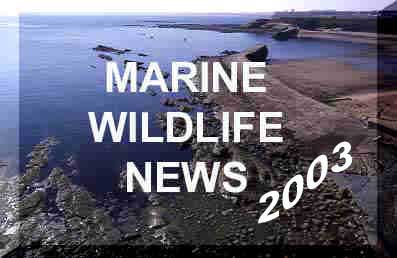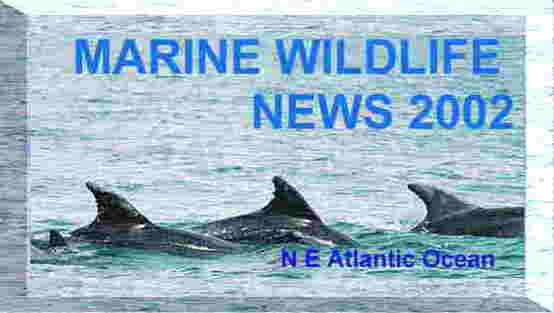
|
|
|
|
|
(BMLSS *** Site) |
|
|
|
Norwegian Marine*** |
|
L-I-N-K-S to Other Sites (Click on Text) |
|
Smart Group |
 |
|
|
|
|
|
|

SUMMER 2004
Reports of marine wildlife from all around the British Isles, with pollution incidents and conservation initiatives as they affect the fauna and flora of the NE Atlantic Ocean.
on Microsoft Internet Explorer (best) or Netscape
 |
 |
 |
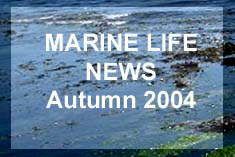 |
LATEST NEWS:
WILDLIFE REPORTS AND NEWS
Late September 2004
A jack fish known as the Blue Runner, Caranx crysos, was caught by a fisherman in a bass net just off Mevagissey, Cornwall, and taken in to Chris Gilbertson at Mevagissey Aquarium, who passed it on to me for identification. This is thought to be the fourth or fifth specimen of this fish reported in the UK.The jack family of fish (Carangidae) are widespread in the warmer waters of the world, but the only member of the family which is common in the North East Atlantic is the Horse Mackerel or Scad Trachurus trachurus. Carangids seem to be being found more regularly as the temperature of local waters increases.
Report from Doug Herdson (National Marine Aquarium, Plymouth)
on the Marine Wildlife of the North-east Atlantic Ocean Group29 September 2004
One of the most extraordinary shark tales involved the discovery of a tropical Oceanic White-tip Shark, Carcharhinus longimanus, that had badly lost its way and was discovered swimming around a warship in a brackish water fjord near Gullmarsfjorden in west Sweden. It died shortly afterwards. The shark, a male, was 230 cm long, (total length), and weighed 65.65 kg. This is the first record in northern European seas and it has never been discovered around the British coast. A Swedish Museum in Gothenburg has now the shark for further examination.Report and Identification by Kent AnderssonThe Oceanic White-tip Shark is found worldwide in epipelagic tropical and subtropical waters between 20° North and 20° South latitude. Its range is from Portugal to the Gulf of Guinea in the eastern Atlantic. There are a few records from the Mediterranean Sea. It lives in sea temperatures above 21° C. It is usually found over deep water a long way from the shore. It is known to assocauite with Pilot Whales and may follow boats or ships if a constant food source is available. This shark has a reputation for attacking Man.
How could the shark have arrived in the fjord? The speculation could involves man's activities as a discard from a deep water fishing catch?
Further Information
Fishbase entry
BMLSS Sharks28 September 2004
A Sowerby's Beaked Whale, Mesoplodon bidens, has been found dead on the beach at Fishguard, south-west Wales. Earlier in the day a similar whale was stranded at Llangrannog near Newquay in Wales and successfully helped back into the sea.Report by Phil Lewis on British Divers' Marine Life Rescue News
27 September 2004
Pair trawling for sea bass banned in UK Territorial waters
Fisheries Minister Ben Bradshaw has announced a unilateral ban on pair trawling for seabass effective immediately at the Labour Party conference in Brighton.
The ban will be implemented within the 20 km (12 mile) limit of the UK's waters. This will not prevent the dolphin deaths but will prevent any more damage to inshore breeding grounds.
BBC News Report25 September 2004
A 20 metres long, 30 tonne, Fin Whale, Balaenoptera physalis, was washed up dead on the mud flats at at St Brides, West Usk, in south Wales, near Newport on the shores of the Bristol Channel.
18-25 September 2004
The massive stranding of By-the-wind Sailors, Velella velella, has now been established that it has stretched much further than just the Cornish coast and that the numbers were in billions. Reports of large numbers of large specimens and huge numbers occurred all along the Welsh coast as far north as Anglesey and almost certainly further north as well.Velella on Constantine Bay beach, north Cornwall
Photograph by Amanda BertuchiSome Reports:
24 September 2004
Thousands of Velella were washed up at Woolacombe, north Devon in unprecedented numbers, estimated up to 200 a square metre!
Report by David Jenkins via Gavin BlackAt Westwood Ho!, north Devon Velella are two or three inches (50 - 75 mm) thick on the shore.
Devon Biodiversity Records Centre (DBRC)
c.18 September 2004
Several hundred By-the-wind Sailors arrived on the beach on the Isle of Islay, west Scotland. The flesh rotted away quite quickly.Report by Malcolm Ogilvie on UK Wildlife Yahoo GroupEarly September 2004
16 September 2004
Velella were found on the shore between Newquay in Wales and Aberaeron with a length of 60 mm +. There was one every three metres or so around the rocks at Cei Bach thinning out in the sand areas. All were strikingly large compared to those I have found before in south Wales and Cornwall before. All had soft tissue and colour but were dead and disintegrating.
We found large amounts of Velella velella out off the Pembrokeshire coast back at the start of Septernber and the ensuing storms seem to have deposited many of them on our beaches in the west of Pembrokeshire (at least). Their small size make them easy to overlook at sea and also on dark sand but they are exquisite jewel like creatures.
21-23 September 2004First strandings on Velella on the sandy beach at Polzeath, Cornwall
Photograph by Jonathan Smith
A huge mass stranding of By-the-wind Sailors, Velella velella, occurred all along the north Cornish coast from Sennen Cove (near land's End) up to Polzeath (near Padstow) and beyond. (As the gull flies this is a distance of 25+ miles and with all the coves and inlets the shoreline is over double this.) Coming in on the top of the tide, there were hundreds of millions* of them, all large, the largest I found was 85 mm, and all them were intact. Millions of Barnacles were washed up along the strandline.
(* Numbers not calculated. At Gwithian they formed a band 10 metres wide on the shore and stretching for over a mile. The above photograph understates the extent of the stranding.)
The Buoy Barnacles, Dosima fascicularis (=Lepas), started coming in on the same tide as the Velella. I've seen with my own eyes on Porthcothan (SW 8572), Treyarnon and Constantine and Paul Gainey saw them on Gwithian, all in north Cornwall. I'd be very surprised if they weren't all the way up the coast and I'd number them in millions, all big. The Goose Barnacles, Lepas, are occurring in their usual quantity for this time of the year, if anything, less. To give you an idea, on my beach, Pothcothan, 25 acres at low tide: Velella approximately one million, Buoy Barnacles: 2000+, Goose Barnacle colonies: 7.
Report by Nick Darke via the Cornish Mailing List
Buoy Barnacle, Dosima fascicularis Photograph © Richard Lord (Guernsey)
The Buoy Barnacles were attached to floats that they had secreted that had a texture like that expanding foam.
Goose Barnacles, Lepas, washed up on Constantine Beach, Cornwall Photograph by Amanda Bertuchi
A large colony was also washed up attached to a log on Porthtowan Beach, Corwall.
Report by Lindsey Vincent
on the Cornish Marine Sightings web pagesBMLSS Velella Reports
Cornish Wildlife Velella page
BMLSS Strandlining
BMLSS Jellyfish and other Medusae
BMLSS BarnaclesMid-September 2004
An Amberjack Seriola sp., caught by an angler off the rocks of the Lizard peninsula, Cornwall, in mid-September and taken to Matt Slater at the Blue Reef Aquarium in
Newquay for identification, will be a new British rod-caught record. It is thought to be a Lesser Amberjack,Seriola fasciata, which has never been recorded in Britain before, but could turn out to be an Almaco Jack, Seriola rivoliana, which would be the sixth for British waters, and the first taken by an angler.Report from Doug Herdson (National Marine Aquarium, Plymouth)UK Public Aquaria List
on the Marine Wildlife of the North-east Atlantic Ocean Group
9 September 2004
A six metres long Minke Whale, Balaenoptera acutorostrata, is seen in Falmouth Bay, Cornwall, when it surfaced next to the boat on five occasions.Report by Pam McNaughton and another report by S. Gulpin
on the Cornish Marine Sightings web pages
c. 6 September 2004
A Moray Eel, Muraena helena, was recently caught just south of Mine Head, Waterford, Ireland. This is the first record of this southern species from Ireland.
1 September 2004
The European Commission in Brussels rejected Britain's call for a ban on pair trawling for bass throughout the English Channel to save dolphins.
Ben Bradshaw, the fisheries minister, had asked the European Commission for an emergency ban after hundreds more dolphins were washed up dead on the beaches of the South-West this year.
BBC News Report
28-29 August 2004
Third National Whale and Dolphin Watch (sponsored by BG Group, DEFRA &
the Heritage Lottery Fund) took place around the UK with watches conducted from about 200 sites from Shetland to Cornwall & the Channel Islands.
Sea Watch FoundationAugust 2004
Brian Richardson diving in 18 metres of water off the South Devon Coast thought he saw the unusual echiuran species known by the scientific name of Bonellia viridis. Only the proboscis was seen, which was about 60 cm long with a T piece 10 cm wide. When touched, the expandable proboscis recoiled under a rock.Report from Doug Herdson (National Marine Aquarium, Plymouth)
on the Marine Wildlife of the North-east Atlantic Ocean Group
I expect most people have not had a chance to see such a bizarre and unusual creature.Image of the this species discovered off Norway (to see how bizarre it is)
Link to the Second Photograph of the extendable proboscis by Rudolf SvensenThis "spoon" worm is classified in the Phylum Echiura.
The females of Bonellia viridis are up to 2 metres in length, while the males are merely 1-2 mm (!) and live as parasites within the uterus of the female! This is the most extreme size difference between male and female (called "sexual dimorphism") found in the animal kingdom!
This is not only strange things about the bionomics of this peculiar animal. For more information click on the link below:Bonellia viridis Information Page (by René Hessling)
The distribution of Bonellia viridis around the British Isles is unclear. I have not received any reports from divers in British waters before, although off Norway it will be found in depths of 25 metres, but usually deeper. It frequents shallow water in the Mediterranean Sea, e.g. off Chios, a Greek island in the Aegean Sea.
More Information
Another Treatise
Even More InformationMore Echiurans (By Erling Svensen)
7 August 2004
The Sunfish, Mola mola, photograph was taken on 7th August 2004 about half a mile off Old Harry Rocks in Dorset. I spotted the Sunfish on the surface and I have seen them in the same area before. Normally when approached they swim towards the bottom at high speed. This time the Sunfish swam towards the boat and even allowed me to touch it, it made no attempt to swim away. It swam around the boat a few times and came back to the swim platform again. I could see it had sea lice on its back and I guess it was trying to get them removed. The fish appeared to be in good health, a fantastic site to see.
Report and Photograph by Lee FordBMLSS Sunfish
Sunfish Reports 20046 August 2004
Fishing the River Hayle in Cornwall, in the evening, I caught three Gilthead Bream, Sparus aurata, one of about 6-7 cm and two of about 16-20 cm long. All three were released. There may well have been a large number of the little bream as my bait was attached by small fish almost every cast.Report by Trevor Opie on the Cornish Wildlife (Yahoo Group)NB: Gilthead Bream is a southern species which is now believed to breed off the south-west coast of Britain.1 August 2004
The Humpback Whale, Megaptera novaengliae, has been in the Sound of Sleat, (separating the Isle of Skye with mainland Scotland), feeding on large shoals of sprat, along with 20 to 30 Minke Whales, Balaenoptera acutorostrata. I've spent many hours with it over the last week (we have a team up there working on the Minkes at the moment).July 2004
BMLSS Halibut
A huge Atlantic Halibut, Hippoglossus hippoglossus, weighing 190 kg was caught from Vannaya Troms, Norway by Thomas Nielsen from Vannaya Troms, Norway.July 2004
We discovered a 1.93 metres (6 ft 4 in) long fresh shark washed up dead on the beach between Hornsea and Mappleton on the Yorkshire North East coast.Report by Rae Atkins
Photographs by Rae Atkins
This shark appears to be a Porbeagle Shark, Lamna nasus. There is a population of this large predatory shark in the North Sea. Their occurence may match the Salmon on which they prey. Specimens washed up dead on the beach are unusual.
BMLSS Sharks12-14 July 2004
We sailed through hugh masses of By-the-wind Sailors, Velella velella, on route from Larne (Northern Ireland) to La Coruna in Spain; it took us approximately two days to clear them. Buoy Barnacles, Dosina fascicularis, attached to floats that they had secreted, were also present in very large numbers.Report by Claire Mullen
12 July 2004
An unfamiliar seaweed washed up in a rockpool at Les Écréhous (a small island reef six miles off Jersey) was identified as the the non native species Grateloupia filicina var. luxurians. The main frond in the photograph is about 20 cm long.
Summary Report
Enlarged Image
ID by members of the Algae-L Mailing List
c. 4 July 2004
While diving at the Shiant Isles in the in the Minch between Skye and Lewis in the Outer Hebrides (islands off north-west Scotland) I found the large starfish Stichastrella rosea, an echinoderm I have never seen outside of St Kilda.Better still, I also found what looks like this starfish but it had seven arms instead of the usual five. This starfish seems to be uncommon and found off the northern and western coasts, usually in deeper water than 30 metres so it is rarely seen by divers.
3 July 2004
In the entrance to the Cromarty Firth (NE Scotland), a pod of Bottle-nosed Dolphins, Tursiops truncatus, were bow-riding a submarine! A surfaced submarine appeared heading out into the Moray Firth and was quickly joined by a group of about ten dolphins; some followed behind riding in the wake while a group at the front were bow riding within a few metres of the vessel.Report by John Poyner on UK CetnetBMLSS CetaceansJuly - August 2004
Triggerfish, Balistes capriscus, are being caught by anglers, seen by divers and even rockpoolers and caught by trawlermen all around the south and west of the British Isles, notably the Channel Islands, Sussex and Dorset coasts, and the coast of Wales.
BMLSS Triggerfish
Triggerfish on the Royal Adelaide
All reports by Andy Horton unless the credits are given to other observers or reporters.
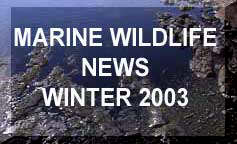 |
 |
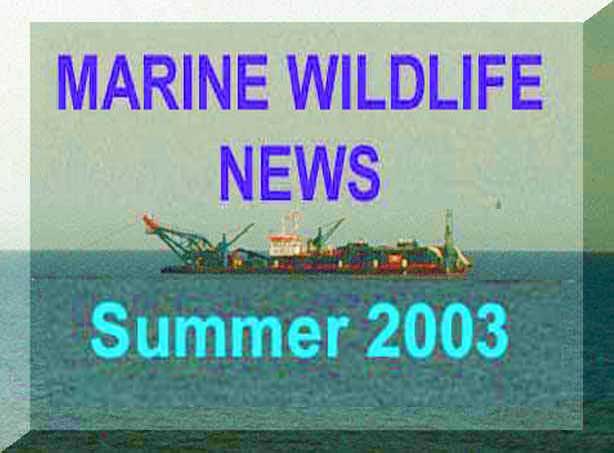 |
 |
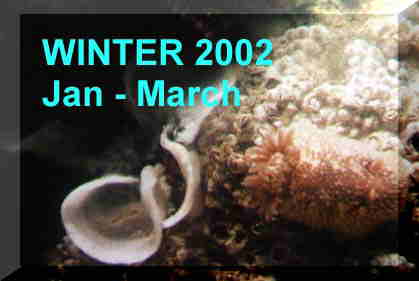 |
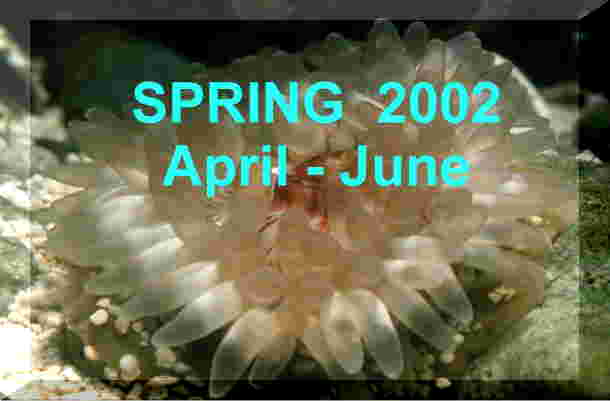 |
 |
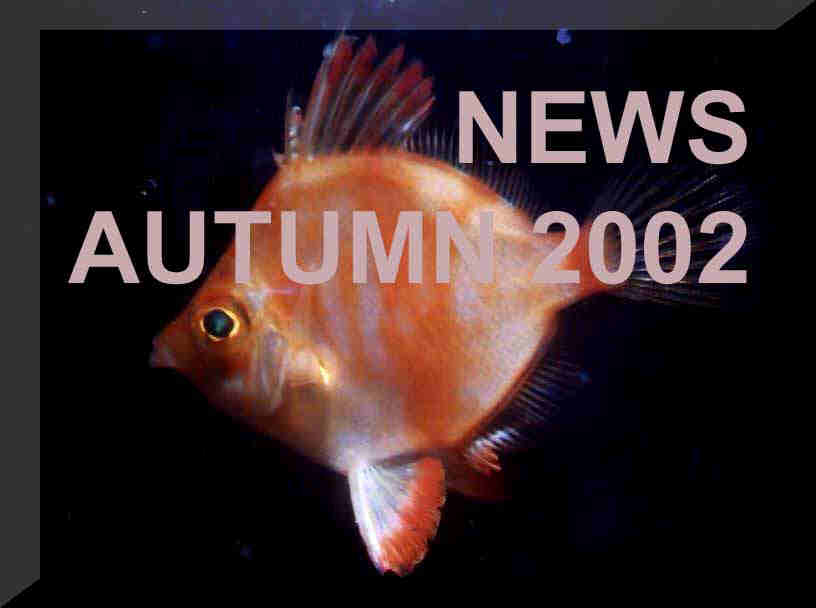 |
FOR EARLIER REPORTS CLICK ON THE BUTTON BELOW

The Marine Wildlife of the NE Atlantic Forum commences.
PLEASE JOIN

MARINE WILDLIFE of the NE ATLANTIC EFORUM PAGE (LINK TO)
Nature Notes Webring
News 2002
News 2001
News 2000
News 1999
|
Use these links if your are familiar with the scientific classifications of marine life |
The BMLSS (England) site commenced on 1 January 1997.
|
|
 |
 |
Andy Horton, Webmaster
|
|
|
|
|
|
Membership Form |
News 2001 News 2000 |

